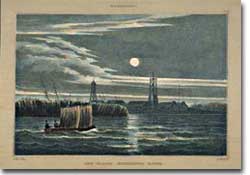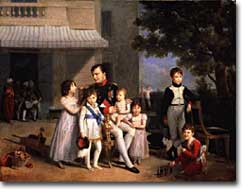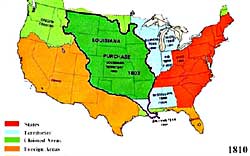20c. Westward Expansion: The Louisiana Purchase

One of the first colored illustrations to be put into print, John H.B. Latrobe's The Balise. Mississippi River captures the haunting image of a navigation station under a full moon at the mouth of the Mississippi River.
Jefferson's plans for the nation depended upon western expansion and access to international markets for American farm products. This vision was threatened, however, when France regained control of Louisiana. Napoleon, who had now risen to power in the French Revolution, threatened to block American access to the important port of New Orleans on the Mississippi River. New American settlements west of the Appalachian Mountains depended upon river transport to get their goods to market since overland trade to the east was expensive and impractical.
Blocking American access to New Orleans was such a grave threat to American interests that President Jefferson considered changing his traditional foreign policy stance to an anti-French alliance with the British. At the same time that he sent diplomats to France to bargain for continued trade access along the Mississippi, he also sent diplomats to Britain to pursue other policy options. James Monroe, the top person negotiating in Paris, was empowered to purchase New Orleans and West Florida for between two and ten million dollars.
Surprisingly, however, Napoleon offered much more. He was militarily overextended and needing money to continue his war against Britain. Knowing full well that he could not force Americans out of the land France possessed in North America, Napoleon offered all of Louisiana to the U.S. for 15 million dollars. The massive territory stretched from the Mississippi River to the Rocky Mountains and more than doubled the size of the United States.

Napoleon's asking price worked out to be about four cents an acre.
The deal was struck in April 1803, but it brought a good deal of controversy. While American development in the 19th century depended on western expansion, it also raised controversial issues that might lead to the disunion of the United States. Some New England Federalists, for example, began to talk of seceding from the U.S. since their political power was dramatically reduced by the purchase.
Further, Jefferson had clearly not followed his own strict interpretation of the Constitution. Federalist critics howled that the Constitution nowhere permitted the federal government to purchase new land. Jefferson was troubled by the inconsistency, but in the end decided that the Constitution's treaty-making provisions allowed him room to act.
Most of the Senate agreed and the Louisiana Purchase easily passed 26 to 6. The dramatic expansion also contradicted Jefferson's commitment to reduce the national debt as swiftly as possible. Although 15 million dollars was a relatively small sum for such a large amount of land, it was still an enormous price tag for the modest federal budget of the day.

Thomas Jefferson's purchase of the Louisiana Territory in 1803 — over 600 million acres at less than 4¢ an acre — was an economic as well as a political victory, as it avoided a possible war with the French.
The Louisiana Purchase demonstrates Jefferson's ability to make pragmatic political decisions. Although contrary to some of his central principles, guaranteeing western expansion was so important to Jefferson's overall vision that he took bold action. The gains were dramatic, as the territory acquired would in time add 13 new states to the union. In 1812, Louisiana became the first state to join the union from land bought in the purchase. Louisiana was allowed to enter the United States with its French legal traditions largely in place. Even today, Louisiana's legal code retains many elements that do not follow English common law traditions. The federal system could be remarkably flexible.






